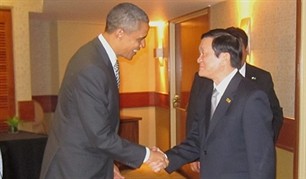Political analysts say this year the US has made the most extensive diplomatic efforts in the last 20 years. A highlight was the acceleration of the US Return to Asia strategy. President Barack Obama, Secretary of State Hillary Clinton and many other US officials have confirmed by word or action the Asia – Pacific region’s importance to the US. Minh Hien, VOV Washington - based correspondent analyses what is behind the US strategy.
 |
| President Barack Obama welcomes President Truong Tan Sang in Hawaii |
After the September 11
th attacks, the US placed its top priority on fighting terrorism in the Middle East. Over the last decade, while the US was concentrating on wars in Afghanistan and Iraq, the Asian region entered a new growth period and surpassed other regions economically. More than half of the world’s population lives in Asia. The region accounts for half of the world’s trade revenue and 60% of the US’ export revenue. Asia is considered the world’s most dynamic region, with emerging economic superpowers like China and India, beginning to challenge the US.
The US is turning toward prosperous Asia in the midst of economic difficulties at home, deep crisis in the EU, and turmoil in the Middle East and Africa. In its security strategy in the Asia-Pacific region, the Obama administration stresses three main reasons to re-establish US influence in this region: the Asia-Pacific region’s increasing status, US interests, and growing challenges in this region. The region has the densest population and the fastest economic growth and wealth accumulation. It has the largest military forces, the greatest potential for military growth, and the most serious nuclear proliferation problem. The US is to face with the emerging economies of China and India, nuclear issues in North Korea and Iran, and terrorism in several South Asian nations.
Secretary of State Hillary Clinton’s speech at the Asia Pacific Economic Conference indicated that Asia will occupy the centre stage in strategic and economic affairs in the 21st century. Ernest Bower, Director of the Southeast Asia Program of the Center for Strategic and International Studies, says President Obama has identified Asia as part of the solution for the US to escape its current stagnation. In order to boost the American economy and generate more jobs, Obama hopes to double American exports by 2015 and the Asia – Pacific will play a key role in realizing this aim.
The US has already taken specific steps in its Return to Asia strategy. First, it has tightened relations with important allies – Japan, South Korea, and Australia and strengthened its strategic partnerships with India and Indonesia. The US classifies Southeast Asian nations as its official allies, strategic partners, or potential strategic partners. In 2020, the US kicked off its Action Program in the Sub-Mekong region, which includes Laos, Cambodia, Thailand, and Vietnam. President Obama attended the Southeast Asia summit last year. At the APEC Summit in Hawaii in November, Obama announced the Framework Agreement for the Trans-Pacific Partnership, considered a major piece of the US return to Asia.
American diplomats have tried to show that they never left the Asia – Pacific. US National Security Advisor Tom Donilon says by emphasizing the priority of the region, President Obama has shown his determination not to allow US long-term interests in the region to be affected by crises elsewhere in the world.
Minh Hien